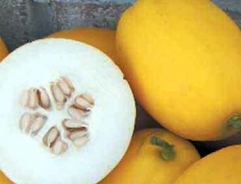Carbonized melon seeds were also discovered in eastern Iran and dated to ca. 2000 BC. The domestication process of melon started in Egypt around 2000 BC. From this area, melon dispersed throughout the Middle East and Asia, where a secondary domestication and diversification development may have occurred. Indo-Aryans knew about Cucumis melo before coming to Indian subcontinent from central Asia in 2000 BC.
A travelogue description indicates the presence of sweet melons in Khorasan and Persia by the mid-10th century. Agricultural literature from Andalusia documents the growing of mango melons there by the second half of the 11th century, which probably arrived from Central Asia as a consequence of Islamic conquest, trade and agricultural development.
There is some discussion as to how they arrived in America, as William Woys Weaver shows Samuel Wilson, a seedsman in Mechanicsville (Bucks County), Pennsylvania, offered seed in the Farm Journal in February of 1889.
Another source shows they were first described in 1849 by Charles François Antoine Morren, a Belgian botanist and horticulturist, as well as the Director of the Jardin botanique de l’Université de Liège in the early to mid-1800s. He apparently obtained his trial seed from Cuba and brought them to Belgium for study.
The name Cucumis melo was introduced by Linnaeus (1753) for domesticated plants cultivated in Uppsala, Sweden. Morphologically similar wild-collected plants were later described from Africa, Asia, and Australia under multiple different names for each continent, but all were subsequently synonymized with and thus included in C. melo.
In 1859, the French botanist Charles Naudin using mostly living plants grown in the gardens of the Natural History Museum of Paris, proposed the first useful system of infraspecific categorization for C. melo L. Naudin (1859) subdivided this species into ten groups, which were later revised by Munger and Robinson (1991), proposing trinomial name.
The vine peach became a well-known commercial variety in Europe soon after, where it might have come to America. Regardless of how vine peach arrived, in the early 20th century it was being commercially grown for pickled foods and preserves.
History of vine peach (mango melon)



